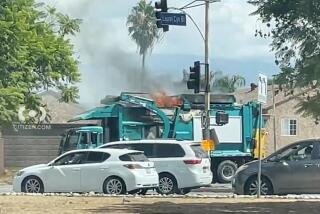High-Tech Trash Truck Nearly Ready to Start Recycling Trial
After months of delays, an Ontario firm is putting the finishing touches on a high-tech garbage truck that is the key to a pilot trash recycling program planned for five neighborhoods in the San Fernando Valley.
Originally scheduled to begin in October, the project, which will serve 1,500 households, was delayed when the $145,000 truck failed a field test, said Robert Alpern, principal sanitary engineer with the city Bureau of Sanitation.
If household participation is high and the city can find a buyer for the mashed mix of glass, metal and paper that will be collected, the recycling effort may be expanded citywide, Alpern said. The goal is to make a little money off the recycled material, which residents will be asked to leave at curbs in 20-gallon containers, while reducing the trash that the city sends to landfills.
As for the delay, Alpern said, âWhen youâre building something thatâs never been built, you have to expect some problems.â
Delivery Next Week
The truck, which is to be delivered to the city by the end of next week, was designed and built by Amrep Corp., which produces about 580 standard garbage trucks a year, 120 of those for the city sanitation bureau, according to company President Jose Ghibaudo.
Several years ago, armed with a grant from the California Waste Management Board, the city sanitation bureau came up with a design for a truck that could accept recyclables and standard trash, Alpern said.
Design âToo Complicatedâ
Amrep came in with the low bid, but rejected the cityâs design because, âThe design they gave me was impossible, much too complicated for the driver,â Ghibaudo said.
He came up with a design that would require less extra effort and training for the driver.
The result is a truck that, from the outside, looks like any other city garbage truck but inside is completely different. Its cost, though high, is not much more than the $100,000-plus that a standard garbage truck costs, Ghibaudo said. In most garbage trucks used by the city, the household trash is emptied into a bin lowered in front of the cab by two metal arms, lifted over the cab and dumped into a cavernous compartment, where a hydraulic plunger compresses it rearward.
Separate Compartments
On the modified truck, the bin has two sections, one for standard trash, the other for recyclables. When the bin is lifted and dumped, the recyclables fall into a separate compartment--constituting a fourth of the truckâs capacity--situated above the larger compartment for standard trash. A separate hydraulic plunger crushes the recyclable trash.
The standard load is emptied through the back and the recyclables fall out of a hatch on the side.
The failure during the truckâs first test came when the recyclables were crushed, Alpern said. The metal walls of the smaller compartment, which were designed to be light in order to keep the truckâs center of gravity low, bulged when the 1,800-pound-per-square-inch pressure of the plunger bore down on a load.
Ghibaudo said the revised design is stronger.
If the truck passes muster and the program is expanded, the city could order many more of the vehicles. There has also been interest in the design from private contractors, Ghibaudo said, because the less trash they have to haul to landfills, which charge a fee for every load, the more money they can make.
The Valley project differs substantially from two other large-scale recycling efforts, one on the Westside and the other in Burbank, Alpern said. In those programs, a household uses three or more containers to separate types of recyclable material--paper, metal, glass--and other garbage. Those programs also require more work by sanitation workers, who must dump the containers manually into separate compartments on a truck.
In the Valley program, each household will be given a single 20-gallon container for all recyclables. A lone sanitation worker will drive the truck on a regular weekly run and pick up both the regular garbage and the recycling container, but will not have to deal with an array of different materials, Alpern said.
Assess Potential Value
The mixed recyclables will be sold to a commercial recycling firm, which will separate the materials for resale. One goal of the Valley program, Alpern said, is to get a good estimate of the proportions of various materials that will be collected so that recycling companies can assess the value of a contract with the city.
Another goal of the program is to test the response to a recycling program in a variety of neighborhoods. The expectation is that, âIn an affluent area, people are more cognizant of the need to recycle,â Alpern said.
The response to the Westside program, which began in 1985, has been excellent, Alpern said, with 60% to 70% of households actively participating. But, because that effort is taking place in affluent neighborhoods, that participation rate may be an exception, he said.
The designated Valley routes lie near the intersections of Chatsworth Street and Zelzah Avenue in Granada Hills, Polk Street and the Foothill Freeway in Sylmar, Odell Avenue and Apperson Street in Sunland, Fallbrook Avenue and Oxnard Street in Woodland Hills, and Zelzah Avenue and Hatteras Street in Encino.
If the recycling program is expanded citywide, it is expected to reduce by about 10% the amount of refuse bound for Los Angeles landfills, Alpern said. But every bit will help.
âOtherwise, in seven or eight years, weâre going to run out of room,â he said.
More to Read
Sign up for Essential California
The most important California stories and recommendations in your inbox every morning.
You may occasionally receive promotional content from the Los Angeles Times.










